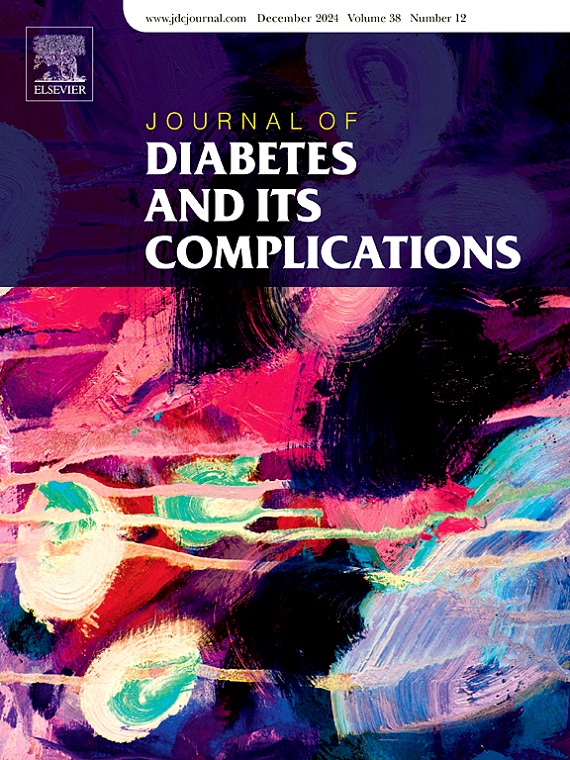干眼病和糖尿病之间有联系吗?系统回顾和荟萃分析
IF 3.1
3区 医学
Q3 ENDOCRINOLOGY & METABOLISM
引用次数: 0
摘要
干眼病(DED)是一种常见的泪液和眼表的多因素疾病,近年来引起了学者们的兴趣,特别是与糖尿病(DM)的联系。本研究旨在通过对现有已发表文章的全面系统回顾和荟萃分析,评估糖尿病与DED之间的关系,从而了解糖尿病患者发生DED的归因风险。方法电子检索PubMed、Cochrane Library (CENTRAL)、Web of Science和谷歌Scholar四个数据库,检索相关文献。我们考虑了近10年来发表的关于糖尿病人群DED患病率的英文同行评议文章。我们的统计分析采用随机效应模型,采用优势比(OR)和风险比(RR)及其各自的置信区间来确定合并效应大小。结果本研究纳入23项研究,共5566名受试者。糖尿病患者的干眼病(DED)患病率明显高于非糖尿病患者(OR: 2.30 [95% CI: 1.54-3.43]; RR: 1.69 [95% CI: 1.28-2.25])。年龄较大(50岁)、糖尿病病程较长(10年)和血糖控制不良(糖化血红蛋白7%)与DED风险增加相关。基于性别的调查结果各不相同,男性的几率略高,但没有统计学意义。观察到高异质性(I2 = 72%),但敏感性分析证实了结果的稳定性。极少发现发表偏倚。糖尿病与DED相关的机制包括氧化应激、炎症和神经病变相关的撕裂功能障碍。结论我们的研究证实了糖尿病与DED患病率和严重程度之间存在显著相关性,糖尿病患者发生DED的风险更高。这些风险在老年人中尤为明显,尤其是那些被诊断为2型糖尿病的老年人。”因此,早期发现和处理糖尿病患者的DED是提高患者生活质量的重点。本文章由计算机程序翻译,如有差异,请以英文原文为准。
Is there a link between dry eye disease and diabetes mellitus? A systematic review and meta-analysis
Background
Keratoconjunctivitis sicca, or the dry eye disease (DED) is prevalent multifactorial disorder of the tears and ocular surface, which has lately been interested scholars, particularly in establishing its link with diabetes mellitus (DM). This study aimed to evaluate the association between DM and DED through a comprehensive systematic review and meta-analysis of existing published articles, and thus understand the attributed risks for DED development in diabetic patients.
Methods
Four databases, PubMed, Cochrane Library (CENTRAL), Web of Science, and Google Scholar, were electronically searched for relevant publications. Peer-reviewed articles in English language reporting on DED prevalence among diabetic population published over the last 10 years were considered. A random effect model with odds ratio (OR) and risk ratio (RR) and respective confidence intervals were used in our statistical analysis to determine pooled effect sizes.
Results
This study included 23 studies with 5566 participants. Diabetic individuals had a significantly higher prevalence of dry eye disease (DED) than non-diabetics (OR: 2.30 [95 % CI: 1.54–3.43]; RR: 1.69 [95 % CI: 1.28–2.25]). Older age (>50 years), longer diabetes duration (>10 years), and poor glycemic control (HbA1c >7 %) were associated with increased DED risk. Gender-based findings varied, with slightly higher odds in males, though not statistically significant. High heterogeneity (I2 = 72 %) was observed, but sensitivity analyses confirmed result stability. Minimal publication bias was detected. Mechanisms linking diabetes to DED included oxidative stress, inflammation, and neuropathy-related tear dysfunction.
Conclusions
Our study confirmed a significant association between DM and DED prevalence and severity, and diabetic patients exhibit higher DED risks. These risks are pronounced in older adults, particularly those diagnosed with T2DM.”. Hence, early detection and management of DED in diabetic population is a priority to enhance patient's quality of life.
求助全文
通过发布文献求助,成功后即可免费获取论文全文。
去求助
来源期刊

Journal of diabetes and its complications
医学-内分泌学与代谢
CiteScore
5.90
自引率
3.30%
发文量
153
审稿时长
16 days
期刊介绍:
Journal of Diabetes and Its Complications (JDC) is a journal for health care practitioners and researchers, that publishes original research about the pathogenesis, diagnosis and management of diabetes mellitus and its complications. JDC also publishes articles on physiological and molecular aspects of glucose homeostasis.
The primary purpose of JDC is to act as a source of information usable by diabetes practitioners and researchers to increase their knowledge about mechanisms of diabetes and complications development, and promote better management of people with diabetes who are at risk for those complications.
Manuscripts submitted to JDC can report any aspect of basic, translational or clinical research as well as epidemiology. Topics can range broadly from early prediabetes to late-stage complicated diabetes. Topics relevant to basic/translational reports include pancreatic islet dysfunction and insulin resistance, altered adipose tissue function in diabetes, altered neuronal control of glucose homeostasis and mechanisms of drug action. Topics relevant to diabetic complications include diabetic retinopathy, neuropathy and nephropathy; peripheral vascular disease and coronary heart disease; gastrointestinal disorders, renal failure and impotence; and hypertension and hyperlipidemia.
 求助内容:
求助内容: 应助结果提醒方式:
应助结果提醒方式:


